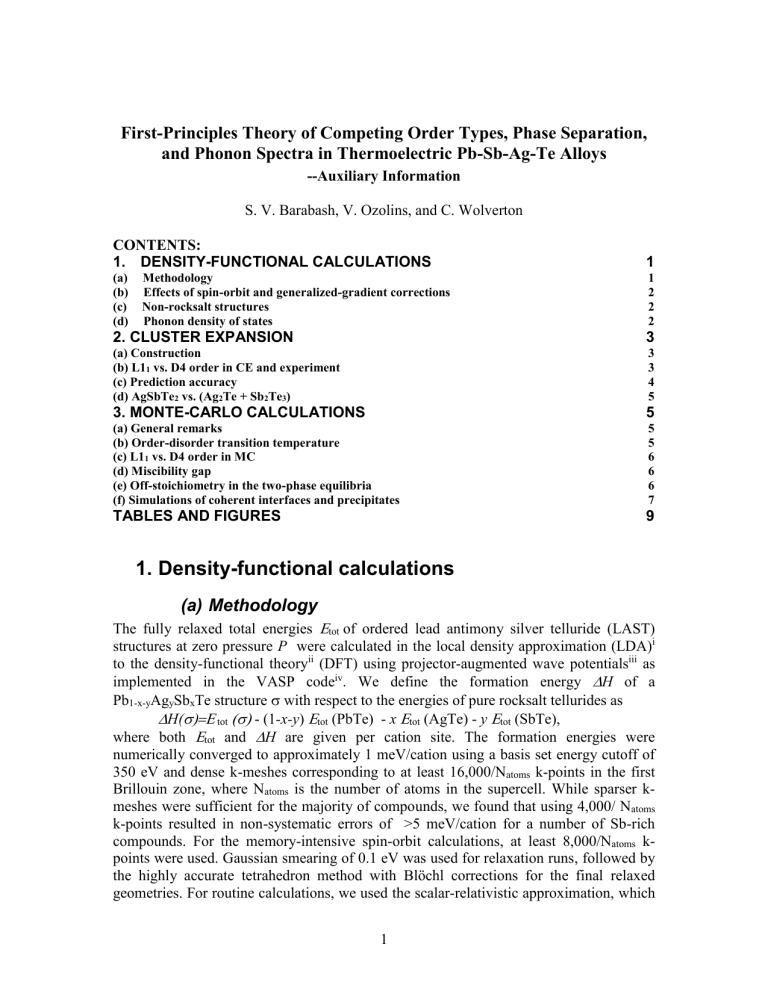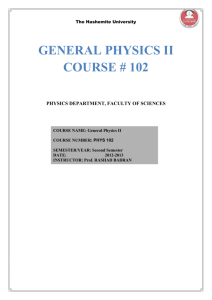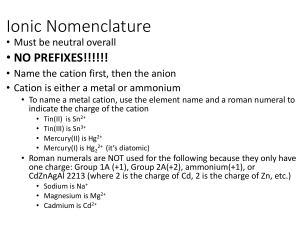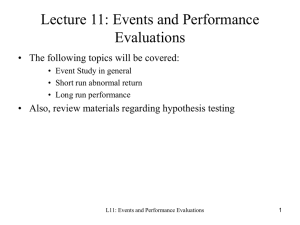corrected SO energies:

First-Principles Theory of Competing Order Types, Phase Separation, and Phonon Spectra in Thermoelectric Pb-Sb-Ag-Te Alloys
--Auxiliary Information
S. V. Barabash, V. Ozolins, and C. Wolverton
CONTENTS:
1.
DENSITY-FUNCTIONAL CALCULATIONS
(a) Methodology
(b) Effects of spin-orbit and generalized-gradient corrections
(c) Non-rocksalt structures
(d) Phonon density of states
2. CLUSTER EXPANSION
(a) Construction
(b) L1
1
vs. D4 order in CE and experiment
(c) Prediction accuracy
(d) AgSbTe
2
vs. (Ag
2
Te + Sb
2
Te
3
)
3. MONTE-CARLO CALCULATIONS
(a) General remarks
(b) Order-disorder transition temperature
(c) L1
1
vs. D4 order in MC
(d) Miscibility gap
(e) Off-stoichiometry in the two-phase equilibria
(f) Simulations of coherent interfaces and precipitates
TABLES AND FIGURES
5
5
5
6
6
6
7
9
3
3
3
4
5
1
1
2
2
2
1. Density-functional calculations
(a) Methodology
The fully relaxed total energies
tot
of ordered lead antimony silver telluride (LAST) structures at zero pressure P were calculated in the local density approximation (LDA) i to the density-functional theory
Pb
1-x-y
Ag y
Sb x
Te structure
with respect to the energies of pure rocksalt tellurides as
H(
where both
tot and ii
(DFT) using projector-augmented wave potentials iii implemented in the VASP code iv
as
. We define the formation energy
H of a
tot
- (1 -x-y )
tot
(PbTe) - x
tot
(AgTe) - y
tot
(SbTe),
H are given per cation site. The formation energies were numerically converged to approximately 1 meV/cation using a basis set energy cutoff of
350 eV and dense k-meshes corresponding to at least 16,000/N atoms
k-points in the first
Brillouin zone, where N atoms
is the number of atoms in the supercell. While sparser kmeshes were sufficient for the majority of compounds, we found that using 4,000/ N atoms k-points resulted in non-systematic errors of >5 meV/cation for a number of Sb-rich compounds. For the memory-intensive spin-orbit calculations, at least 8,000/N atoms
kpoints were used. Gaussian smearing of 0.1 eV was used for relaxation runs, followed by the highly accurate tetrahedron method with Blöchl corrections for the final relaxed geometries. For routine calculations, we used the scalar-relativistic approximation, which
1
omits spin-orbit interaction effects. Since the external pressure is zero, the calculated formation energies are the same as the formation enthalpies.
(b) Effects of spin-orbit and generalized-gradient corrections
In Table A-I, we illustrate how the calculated formation energies of several representative
LAST structures are affected by the choice of the exchange-correlation functional and the treatment of relativistic spin-orbit interactions. In particular, we compare the results obtained using the “standard” settings described in the previous subsection with those obtained using (a) the generalized-gradient approximation (GGA) v
without spin-orbit terms, (b) the local-density approximation including spin-orbit interactions (LDA+SO), and (c) with the results of an earlier study, which used both the GGA and spin-orbit corrections vi
. Table A-I shows that including the spin-orbit interaction leads to a slight increase in the calculated formation energies, while using a gradient-corrected GGA functional leads to a lowering of the formation energies for ternary compounds. In all cases, these choices do not change the general energetic hierarchy among the LAST structures. Particularly, the small energy difference between the competing L1
1
and D4 structures is not affected: D4 is universally found to be lower than L1
1
by values within the range of 1.7 to 2.3 meV/cation.
(c) Non-rocksalt structures
We calculated the energies of known compounds with alternative structures: elemental
Te (in
-Se structure), SbTe, vii
Sb
2
Te, viii
Sb
2
Te
3
, ix
AgTe (in empressite x
and sphalerite xi structures, both observed only as metastable structures xii ), and Ag
2
Te (in the hessite modification). The formation energies relative to the pure elements ,
H xiii elem
(
are compared for these compounds and for the pure rocksalt tellurides (as well as for ordered
AgSbTe
2
) in Table A-II; here we use where x i
is the atomic content of species i in the compound
, and the total energies
tot
H elem
(
tot
- x
Ag
tot
(Ag)- x
Sb
tot
(Sb) – x
Te
tot
(Te),
are given per atom. We did not calculate the partially-occupied 155-atom structure of the Ag
5
Te
3
phase xiv
; however we did calculate a simplified version of that structure with a Ag
36
Te
21
composition, which turned out to have a higher energy than the mixture of Ag
2
Te and Te at the same composition, and therefore is not expected to be stable at
T=0K.
(d) Phonon density of states
The vibrational spectra and the phonon densities of states (PDOS) were calculated for rocksalt PbTe, AgTe, SbTe and for L1
1
-ordered AgSbTe
2
using the supercell frozen phonon approach; for the details of the method, see Ref.xv. The calculations were performed with 2x2x2 and 3x3x3 sampling of the Brillouin zone for the phonon qvectors. We did not calculate PDOS of D4 due to its large cell size and its structural similarity to L1
1
[discussed in Section 2(b) below].
In all of the above compounds, the calculated vibrational spectra did not contain any imaginary frequencies, signifying that the ordered AgSbTe
2
and the rocksalt AgTe and
2
SbTe are all dynamically stable. However, as we discuss in Ref. xvi, calculations of the elastic response suggest that rocksalt SbTe is on the verge of dynamical instability.
2. Cluster Expansion
(a) Construction
A quasi-ternary cluster expansion xvii (CE) as implemented in ATAT xviii is used to describe the ordering energetics of Pb, Ag and Sb cations in quaternary Ag
1-x
Pb
1-y
Sb x+y
Te compounds based on the rocksalt lattice. The cations are assumed to occupy sites on one of the two interpenetrating FCC sublattices comprising the rocksalt structure; the other sublattice is fully occupied by Te ions. Table A-III lists the directly calculated LDA and the fitted CE energies for 86 ordered “input” structures, which were selected iteratively
. The final cluster expansion uses 22 interaction coefficients, including 9
pairs (up to the third nearest-neighbor cation) and 10 three-body interactions (including cations within the second nearest-neighbor distance).
Elastic strain and chemical bonding effects are accounted for in the CE by using the total energies of fully relaxed small-unit-cell ordered structures to derive the values of the effective cluster interactions. This can be contrasted with an earlier MC study of a idealized lattice Coulomb model in Ref.xix, which neglected all chemical bonding and local relaxation effects, and thus lead to predictions that were in a clear conflict with DFT results. Indeed, the Coulomb model predicted preferred orientation of Ag-Sb ion pairs to
be along [110], favoring to structures with alternating ordered (001) layers xix
DFT concludes that the preferred Ag-Sb pair orientation is actually [100] xx,xxi , and that the dominating structures are the (111)-superlattice L1
1
and a related D4 structure, as
discussed in Refs. xxii, xxiii, xvi, and in the present paper.
While our procedure accurately accounts for short-range relaxations in spatially homogeneous ordered and disordered alloys, coherent precipitation and coexistence of immiscible phases often lead to long-range strain fields, which are not treated in our CE.
For instance, it is well known that long-range elastic strains are important for the energetics of long-period superlattices xxiv
and Monte-Carlo simulations of solid-state precipitation xxv,xxvi
. For binary alloys, these effects can be treated approximately by using
the so-called “mixed-basis” CE formalism xxiv ; unfortunately, the mixed-basis CE has not
yet been extended to ternary systems. Since we include short-range strain effects, our CE is expected to provide an accurate account of the incoherent rocksalt-based phase diagram of LAST compounds. The effects of the long-range strain on the coherent phase
diagram will be discussed in detail in a separate publication xvi (we find, for instance, that
the coherency strain does not change the energetics of chemical ordering, but increases the coherent solubility limits).
(b) L1
1
vs. D4 order in CE and experiment
The two structures that are found to be nearly degenerate ground states of AgSbTe
2
, L1
1 and D4, have identical pair- and three-body correlations for any neighbor shell. Here, the
“pair correlation” is proportional to the difference between the number of like and unlike neighbor atoms, averaged over all atom pairs with a given separation; similarly, the three-
3
body correlation function corresponding to a triplet cluster f is defined as an alternating sum,
f
3 n
0
n
N f
(Ag
3
n
Sb n
) , where N f
(Ag
3-n
Sb n
) is the number of Ag n
Sb
3-n triplets per lattice site. The smallest cluster that distinguishes L1
1
from D4 is the fourbody nearest-cation-neighbor tetrahedron: L1
1
is comprised of Ag
3
Sb and AgSb
3
, and D4
– of Ag
4
, Sb
4
and Ag
2
Sb
2
tetrahedra. Most other larger four-body clusters can also be used to distinguish between L1
1
and D4.
Experimentally, L1
1
and D4 can be distinguished on the basis of trigonal distortion; xxvii however, the LDA calculations predict that the trigonal distortion of L1
1
is quite small: the c/a ratio is approximately 4.78 in L1
1
, while the cubic D4 structure has c/a=2 6 ≈4.90. Another way to distinguish the two structures is by a direction-sensitive probe, such as single-crystal X-ray diffraction: L1
1
has an ordering vector at a single L point, whereas all four L points are ordering vectors for D4.
The four-body terms responsible for the L1
1
vs. D4 energy difference could not be
identified by the standard CE procedure of Ref. xviii due to the richness of the
composition-dependent energetics. Specifically, using the energies of all the input structures to fit the value of the four-body terms resulted in an incorrect energetic ordering of L1
1
versus D4 (the former becoming lower in energy). Thus, our final CE did not use four-body terms and predicted L1
1
and D4 as exactly degenerate. For the Monte
Carlo runs performed with the purpose of studying the L1
1
vs. D4 competition, we manually introduced four-body terms to fit the small DFT-calculated D4 - L1
1
energy difference. We found that the results of such runs did not depend on which specific fourbody interaction was altered [see Sec. 3(c)].
(c) Prediction accuracy
Two independent measures were used to estimate the predictive accuracy of our CE.
First, we use the leave-one-out cross-validation score (CV score s
CV
), as implemented in
ATAT: s
CV
where
2
1
H
LDA
(
)
˜
CE
(
)
2
,
N
˜
CE
input
is the energy predicted by the cluster expansion obtained excluding structure
and fitting the remaining N input
-1 input structures. Including too many terms in
a cluster expansion typically results in poor predictions (even though the fit error may be
close to zero), which leads to an abrupt increase in the CV score. The CV score was thus used by ATAT to select the above-mentioned 22 interactions as the optimal number. Our final CE has a CV score of s
CV
=24 meV/cation, which amounts to a 6% error on the formation energy scale between the least [AgPbTe
2
with L1
0
cation ordering,
H=246 meV/cation] and the most [AgSbTe
2
with L1
1
cation ordering,
H=-148 meV/cation] stable ordered structures included in the input.
Additionally, we calculated the formation energies of several structures that were not used during the construction of the cluster expansion, which we compare with the CE predicted energies in Table A-IV. The average prediction error for this set is 26 meV/cation. As expected, it is close to the cross-validation score s
CV
.
4
Note that, while the Ag m
Sb n
Te m+n
ground state structures shown in Figure 1 of the main text were all confirmed by LDA, the precision of our cluster expansion is not sufficient to rule out the possibility that other shallow Ag m
Sb n
Te m+n
ground states may exist and be stable at low temperatures (below ~ s
CV
/k
B
~250K).
(d) AgSbTe
2
vs. (Ag
2
Te + Sb
2
Te
3
)
In the experimental literature, contradictory assessments have been made xxviii,xxix
for the relative stability of AgSbTe
2
and the equimolar mixture of Ag
2
Te and Sb
2
Te
3
. In fact, in the presence of defects such as cation vacancies, a complete set of thermodynamic variables includes the defect concentration, in addition to the temperature T and the PbTe vs. AgSbTe
2
composition x.
(At least in some experiments, the concentration of the defects appears to reach ~10% or more, as follows from the observed deviations from the ideal stoichiometry.) The small AgSbTe
2
vs. (Ag
2
Te + Sb
2
Te
3
) energy difference (3.4 meV/atom, cf. Table A-II) suggests that the variation of defect concentration with
experimental conditions might explain the disagreement between refs. xxix and xxviii,
which both controlled only T and x .
3. Monte-Carlo calculations
(a) General remarks
We performed semi-grand-canonical Monte Carlo simulations using the multi-component
Monte Carlo code memc2
, which is part of the ATAT xviii
configuration was defined as a pattern of Ag, Pb and Sb atoms decorating the sites of the cation sublattice; this accounts for the relaxation effects and the presence of the fully occupied Te sublattice via the values of the effective cluster interactions. Nonconfigurational contributions to the free energies (e.g., vibrational entropies), lattice defects (e.g., vacancies), and the possibility of melting are not included. The thermodynamic state of the semi-grand-canonical ( N
Ag
+N
Pb
+N
Sb
=const) ensemble is determined by the temperature T and by the differences between the chemical potentials
µ
Ag
, µ
Sb
and µ
Pb
of the constituents (e.g., µ
1
=µ
Ag
-µ
Sb
and µ
2
=µ
Pb
-µ
Sb
). Periodic boundary conditions were always used.
(b) Order-disorder transition temperature
The order-disorder transition temperature in the AgSbTe
2
phase was determined using two independent numerical methods: finite-size scaling analysis of the three-body correlations and maximum in the constant-volume heat capacity. The three-body correlations were measured along constant-µ lines. The heat capacity at zero pressure was determined by directly differentiating the energy functional
E(µ
1
,µ
2
,T).
This procedure allowed us to calculate the heat capacity in the absence of the information about the variance of the energy (not included in the output in the multi-component code memc2 ).
5
The proper derivatives can be related to the derivatives at constant µ using the average atom numbers of two types of the species, say N
Ag
=N
1
(µ
1
,µ
2 c
P
( E
T
PV )
( P
0
,
) N
1
,
N
2
E
T
1
,
2
i , j
1,2
E
i
T
, i
1
ij
,T) and N
Pb
=N
2
(µ
1
,µ
2
,T), via
N
T j
i
, j
1
, where the Jacobian matrix is J ij
N i
/
j
T
, j
1
.
Monte Carlo cells with up to 24
24
24 cations were used, with 1000 steps per site for each pair of (T, µ
Pb
) values and a temperature step of 5 K. The heat capacity and the
Fig. A-1.
(c) L1
1
vs. D4 order in MC
As mentioned above in Sec. 2(b), the four-body terms responsible for the L1
1
vs. D4
energy difference were not determined automatically by the regular ATAT procedure xviii
In the absence of such four-body terms, L1
1
and D4 were degenerate and each appeared with ~50% frequency during simulated annealing. Upon manually introducing the fourbody terms to fit the D4/L1
1
energy difference, we found that D4 appeared in ~80% simulated annealing runs, regardless of which specific four-body interaction was altered.
24
24
24 MC cells were used, cooled from 1800 K down to 800 K in steps of 50 K, with
1000 steps per site per (T,
µ
Pb
) pair.
(d) Miscibility gap
For the investigation of the miscibility gap in the PbTe-AgSbTe
2
system, the chemical potential of Pb was varied with the chemical potentials of Ag and Sb adjusted to satisfy x
Ag
=x
Sb
, where x i is the atomic fractions of the i' th constituent. The position of the solvus boundary was determined by tracking the discontinuity in the Pb concentration, x Pb (µ
Pb
Hysteresis in x
Pb (µ
Pb
)
).
was observed due to a finite number of MC steps; we found, however, that the hysteresis loop and the resulting uncertainty in the values of x
Pb
at the binodal first-order transition could be made reasonably small by using large numbers of
MC steps [>100,000 attempts per site per pair of (T,
µ
Pb
) values], except at very low temperatures. The remaining uncertainty was treated as a numerical MC convergence error; this error exceeded the finite-size error, which was estimated by increasing the cell size from 6x6x6 to 12
12
12. We found this method preferable to a direct thermodynamic integration of thermodynamic potentials, since the cumulative integration error was found to lead to a serious underestimation of the width of the miscibility gap.
Note that our MC results pertain to an incoherent bulk coexistence of rocksalt-based
PbTe and AgSbTe
2
phases. Long-range coherency strains that exist in a coherently phase
separating alloy are discussed in a separate publication.
(e) Off-stoichiometry in the two-phase equilibria
6
For visual clarity, the phase diagram in the Figure 2 of the main paper text shows the Pbrich phase “ ” and the Pb-poor phases “D4/L1
1
” or “ ” as coexisting at the miscibility gap compositions with exactly charge-balanced Ag and Sb content (x
Ag
=x
Sb
). Strictly speaking, our MC results indicate that at fixed chemical potentials, the ratio x
Sb
/ x
Ag
is different in the two phases, with
(PbTe) tending to be Sb-rich and D4 (AgSbTe
2
) tending to be Ag-rich. The specific phase composition depends on the choice of the chemical potentials; in particular, they can be chosen such that any one (but not both) of the two phases is charge-balanced. As a consequence, within the two-phase
+D4 region, at least one of the coexisting phases must deviate from the charge-balanced x
Sb
= x
Ag stoichiometry. Nevertheless, the miscibility gap boundaries in terms of the Pb content are always as shown in Fig. 2 of the main text; any variations due to the choice of the chemical potentials of Sb and Ag are much smaller than the error bars in Fig. 2.
Similarly, the ordered phase “D4/L1
1
” and the hypothetical disordered phase “ ” coexist with slightly different compositions along the order-disorder transition boundary. The width of the corresponding “miscibility gap” for the latter equilibrium is negligible compared to the error bars in the phase diagram of Figure 2.
Furthermore, deviations from the ideal 1:1 ratio of Ag and Sb content could also be influenced by the presence of vacancies, which may lead to deviations of the cation-toanion ratio from 1:1 (assumed throughout this study), introducing more possibilities in comparison with those shown in Fig. 1 of the main text. In particular, the competing incoherent phases, in addition to the mixtures (Ag
2
Te+Sb
2
Te
3
), (Ag
2
Te+Te) and
(Sb
2
Te+Sb
2
Te
3
), may include Ag
2
Te, Sb
2
Te
3
or Sb
2
Te. Even when the average cation:anion ratio is near 1, these individual phases may precipitate out at the cost of creating vacancies or antisites in the rest of the system. Strong deviations of the cation:anion ratio from 1:1 could also lead to the formation of coherent precipitates with alternative charge-balanced compositions such as Ag
2
Te or Sb
2
Te
3
. All such effects should be a subject of a separate study.
The results of some semi-grand-canonical simulations may show an additional offstoichiometry even in the single phase region. Such deviations reflect imperfect choice of the chemical potentials. For example, the analysis of the Pb site preference in D4 was performed using a Monte Carlo cell with an average composition of Ag
0.45
Sb
0.44
Pb
0.11
Te.
The slight imbalance of the Ag:Sb ratio was caused by using the value of
Ag
-
Sb
that resulted in x
Ag
=x
Sb
at smaller Pb compositions; upon Pb substitution, maintaining the same
Ag
-
Sb
results in slight deviations from the perfect Ag:Sb stoichiometry.
(f) Simulations of coherent interfaces and precipitates
The purpose of these simulations was to characterize the coherent interfaces and precipitates under near-equilibrium thermodynamic conditions, rather than to model the actual growth of the precipitates (which should only be done using a kinetic MC and is beyond the scope of this study.)
The initial states were constructed as follows: PbTe and ordered AgSbTe
2
phases were separately equilibrated in 48
48
48 boxes with periodic boundary conditions at the
7
temperature and chemical potential values representing binodal equilibrium between
PbTe and AgSbTe
2
. Subsequently, an infinite AgSbTe
2
(111) slab of thickness d (for the planar phase boundary simulation) or a spherical region of radius R
0
(for the precipitate shape simulation) were embedded in the PbTe simulation cell. We used d=24, and R
0
=16 or 20 in units of the cation-cation nearest-neighbor distance, which was found to be sufficient for the “matrix” phase to well separate the periodic images of the “precipitate” phase throughout the MC runs, so that the composition and structure far from the phase interfaces were practically identical to those of the corresponding bulk phases.
We compared the results obtained using canonical and semi-grand-canonical simulations.
The canonical simulations (equilibrated for 1000...3000 MC steps/site) do not cause a change in the relative volumes of the phases. In semi-grand-canonical simulations, an imperfect choice of the chemical potentials leads to a slow growth of one of the phases at the expense of the other. While this growth limits the simulation times in semi-grandcanonical simulations, it can also be utilized to estimate the “time unit”
for a local equilibration of the interface (we found that
=20 MC steps/site allows equilibration throughout the width of the diffuse interface). The actual semi-grand-canonical runs were performed for 20...50
.
The results shown in Figure 3 of the main text were obtained using the semi-grandcanonical simulations. The results of canonical simulations, particularly the shape of the precipitates and the width of diffuse boundary are very similar. There is a small difference in the composition profile across the diffuse boundary (a one-layer-wide plateau develops around 50%). This is likely related to the development of step boundaries (averaged out when composition profile across the boundary is measured). In the semi-grand-canonical simulations, the step boundaries are presumably destroyed via the motion of the boundary position, revealing the monotonous profile across a step-free boundary such as shown in Fig. 3(b) of the main text.
8
Tables and Figures
Composition
AgTe
PbTe
SbTe
AgSbTe
2
AgSbTe
2
ATAT code
0
1
2
4 n/a
Name of cation ordering
(notation of
Ref.
fcc (n/a) fcc (n/a) fcc (n/a)
L1
1
(AF-II)
D4 (AF-IIb)
Superlattice formula
(111) -Ag-Te-
(111) -Pb-Te-
(111) -Ag-Te-
(111) -Ag-Te-Sb-Te- not a superlattice
Formation Energy
H (meV/cation)
LDA LDA + SO GGA
0
0
0
0
0 0
-147.9 -131.2
-149.6 -133.5
0
0
0
-187.2
-189.1
GGA+SO
n/a n/a n/a
H(D4) + 1.9
H(D4)
AgSbTe
2
76 CH (AF-III) within fcc, (201) -Ag-Ag-Sb-
Sb-
-89.3 n/a -138.5
H(D4) +37.2
AgSbTe
2
Ag
3
SbTe
4
7
46
AgPbSbTe
3
12
L1
0
(AF-I)
W1 (n/a) none within fcc, (100) -Ag-Sb- within fcc, (311) -Sb-(-Ag-)
3
(111) -Ag-Te-Pb-Te-Sb-Te-
-29.8 -19.4
-79.2 -79.5
-47.5 -45.9
-75.0
-94.8
-82.8
H(D4) +97.8 n/a n/a
Table A-I. Comparison of the formation energies of representative Pb
1-x-y
Ag x
Sb y
Te ordered structures calculated using scalar-relativistic LDA, LDA with spin-orbit
interactions (LDA+SO), scalar-relativistic generalized-gradient approximation v
(GGA), and the data of Ref. vi obtained using the GGA with spin-orbit effects (GGA+SO). [The
latter formation energies are expressed with respect to that of the D4 structure, ΔH(D4),
as limited by the data reported in Ref. vi.] For each structure, we present the structure’s
composition, number code assigned by the ATAT enumeration scheme, name of the ordered structure formed within the cation fcc sublattice (in parenthesis – name used in
Ref. vi), and the way the structure may be generated as a superlattice of pure atomic
layers. The “n/a” entries indicate that the corresponding energies were not calculated (
H column) or that the structure was not generated by ATAT but supplied manually (“ATAT code” column).
9
Composition structure
H elem
(meV/atom)
Ag
Sb
Te
AgTe fcc
-As
-Se
0
0
0 rocksalt -5.6
AgTe
AgTe
Ag
2
Te empressite +0.3 sphalerite +135.6 rt-Ag
2
Te -21.5
AgSbTe
2
SbTe
SbTe
Sb
2
Te
Sb
2
Te
3
D4 -79.0 rocksalt -2.7
SbTe
Sb
2
Te
-96.6
-63.3
Sb
2
Te
3
-118.9
Table A-II. DFT formation energies relative to the pure elements ,
H elem
, for the experimentally reported silver and antimony telluride structures, compared to the rocksalt
AgTe and SbTe, and to AgSbTe
2
with the predicted D4 cation ordering.
10
Composition ATAT
AgTe
PbTe
SbTe
AgPbTe
2
AgSbTe
2
PbSbTe
2
AgPbTe
2
AgSbTe
2
6
7
PbSbTe
2
8
Ag
2
PbTe
3
9 code
0
1
2
3
4
5
Ag
2
SbTe
3
10
AgPb
2
Te
3
11
AgPbSbTe
3
12
AgSb
2
Te
3
13
Pb
2
SbTe
3
PbSb
2
Te
3
14
15
Ag
2
PbTe
3
16
Ag
2
SbTe
3
17
AgPb
2
Te
3
18
AgPbSbTe
3
19
AgSb
2
Te
3
20
Pb
2
SbTe
3
PbSb
2
Te
3
21
22
Ag
2
PbTe
3
23
Ag
2
SbTe
3
24
AgPb
2
Te
3
25
AgPbSbTe
3
26
AgSb
2
Te
3
27
Pb
2
SbTe
3
PbSb
2
Te
3
28
29
Ag
2
PbSbTe
4
33
Ag
2
PbSbTe
4
35
AgPb
2
SbTe
4
38
AgPbSb
2
Te
4
40
AgSb
3
Te
4
41
Pb
2
Sb
2
Te
4
43
Ag
3
SbTe
4
46
Ag
2
PbSbTe
4
50
Ag
3
SbTe
4
61
AgPb
2
SbTe
4
64
Ag
2
PbSbTe
4
65
AgPbSb
2
Te
4
68
H LDA
H CE
0.0
30.4
0.0
18.8
0.0
31.7
70.3
40.4
-147.9
-150.0
125.9
97.1
245.5
241.9
-29.9
-24.6
62.7
53.9
82.8
58.7
-82.7
-84.5
82.2
54.8
-47.7
11.4
-72.2
-84.0
106.9
75.0
86.3
79.3
109.9
118.5
-84.5
-84.1
110.6
104.4
-21.4
-11.6
-75.6
-84.8
80.5
68.4
64.8
63.8
172.4
171.7
-9.7
-28.6
158.9
159.4
50.1
60.6
-34.3
-30.9
58.4
60.4
61.2
61.5
-2.8
24.7
-59.5
-51.8
1.5
72.8
-14.6
-10.3
-37.6
-55.1
85.7
67.2
-79.2
-73.7
-61.0
-71.6
-64.6
-72.3
32.1
35.9
99.5
88.3
-52.2
-50.6
AgSb
3
Te
4
69
Ag
3
PbTe
4
72
Ag
3
SbTe
4
73
Ag
2
PbSbTe
4
75
Ag
2
Sb
2
Te
4
76
AgPb
3
Te
4
77
AgPb
2
SbTe
4
78
AgPb
2
SbTe
4
80
AgSb
3
Te
4
83
Ag
3
SbTe
4
88
Ag
2
Sb
2
Te4 91
AgSb
3
Te4 98
Ag
3
SbTe4 103
AgPbSb
2
Te4 109
AgSb
3
Te4 113
Pb
3
SbTe4 114
Pb
2
Sb
2
Te4 115
PbSb
3
Te4 116
Ag
3
PbTe4 117
Ag
3
SbTe4 118
AgPb
3
Te4 120
AgPbSb
2
Te4 122
AgSb
3
Te4 123
PbSb
3
Te4 125
AgSb
4
Te5 155
Ag
3
Sb
2
Te5 173
Ag
2
Sb
3
Te5 188
Ag
4
SbTe5 199
Ag
3
Sb
2
Te5 202
AgSb
4
Te5 214
Ag
4
SbTe5 220
Ag
3
Sb
2
Te5 223
Ag
2
Sb
3
Te5 232
AgSb
4
Te5 248
Ag
4
SbTe5 256
Ag
3
Sb
2
Te5 259
Ag
2
Sb
3
Te5 268
Pb
4
SbTe5 285
Pb
3
Sb
2
Te5 287
Ag
4
Sb
2
Te6 380
AgSb
5
Te6 598
Ag
3
Sb
3
Te6 636
AgSb
5
Te6 677
Ag
2
Sb
4
Te6 750
-58.9
-74.5
144.5
148.8
-32.5
-39.8
35.0
14.4
-89.3
-81.9
141.4
134.0
73.4
73.2
42.1
60.1
-46.8
-38.8
-39.5
-50.1
-107.1
-103.6
-47.1
-50.3
11.8
-13.9
12.5
7.7
-17.5
-15.3
44.6
50.0
62.9
64.5
46.9
54.1
191.7
191.8
-6.9
-12.2
178.7
183.3
46.4
47.7
-25.6
-9.1
47.2
45.7
-24.8
-37.8
-121.8
-109.4
-105.2
-109.8
-45.6
-43.6
-91.3
-81.1
-34.0
-44.1
-31.2
-34.0
-84.1
-60.3
-70.4
-60.7
-27.3
-33.9
11.9
-5.0
-21.5
-27.0
-31.9
-28.4
37.0
43.7
52.7
55.3
-103.4
-98.2
-23.9
-29.7
-127.4
-119.1
-35.7
-37.3
-77.5
-84.8
Table A-III. Formation energies (in meV/cation) of the rocksalt-based telluride structures used in constructing the cluster expansion (CE), as calculated in LDA and fitted by CE.
11
Composition
AgSbTe
2
AgSbTe
2
AgPbSbTe
3
AgSbTe
AgPb
2
2
SbTe
4
Structure name or ATAT code
D4
34
53
SQS4(8)
AgSb
3
Te
4
56
Ag
2
Pb
1
Sb
2
Te
5
231
SQS6(12)
Ag
4
SbTe
5
127
AgSb
5
Te
6
361
Ag
2
Pb
3
Sb
1
Te
6
334
Ag
5
SbTe
6
Ag
4
Sb
2
Te
6
608
621
Ag
3
Pb
1
Sb
2
Te
6
658
Ag
2
Sb
4
Te
6
674
Ag
5
SbTe
6
687
Ag
2
Pb
1
Sb
3
Te
6
721
H LDA
(meV)
-149.6
-106.7
-13.6
85.7
-17.3
-52.9
-13.1
-39.8
-34.9
+25.9
-34.3
-96.2
-95.6
-78.3
-52.5
-61.4
H CE
(meV)
-150.0
-103.6
+7.7
-51.3
-18.2
-75.9
+28.7
-38.5
-38.2
+34.9
-36.3
-96.4
-95.7
-97.8
-46.1
-83.4
Table A-IV. Formation energies of the additional rocksalt-based structures that were not used in constructing the CE, as calculated in LDA and independently predicted by CE.
The r.m.s. prediction error for this set is 26 meV.
12
Figure A-1.
Heat capacity c
P
of Pb-doped AgSbTe
2
vs. temperature T , illustrating the orderdisorder transition [peaks in c
P
(T) ] at the same temperature T ord
≈1150K at two different sets of chemical potentials, corresponding at 1100K to x
Pb
≈0.2% , x
Ag
=x
Sb
(left panel) and x
Pb
≈16% , x
Ag
=x
Sb
(right panel). Different lines show: 24x24x24 MC box upon cooling (solid black line) and heating (dashed line), and 12x12x12 MC box upon cooling (solid gray line). The insets show the average value of a three-body correlation
3MB1
(in arbitrary units) for 24x24x24 (black),
12x12x12 (dark gray) and 6x6x6 (light gray) MC boxes.
13
i D.M. Ceperley and B.J. Alder, Phys. Rev. Lett. 45 , 566 (1980); J.P. Perdew and A.
Zunger, Phys. Rev. B 23 , 5048 (1981) ii
P. Hohenberg and W. Kohn, Phys. Rev. 136 , B664 (1964); W. Kohn and L.J. Sham,
Phys. Rev. 140 , B1133 (1965).
iii
P.E. Blöchl, Phys. Rev. B 50 , 17953 (1994); G. Kresse, and D. Joubert, Phys. Rev. B
59 , 1758 (1999).
iv
G. Kresse and J. Hafner, Phys. Rev. B 48
, 13115 (1993); G. Kresse and J. Furthmüller,
Comput. Mat. Sci. 6 , 15-50 (1996); Phys. Rev. B 54 , 11169 (1996).
v
J. P. Perdew and Y. Wang, J. Chem. Phys. 45 , 13244 (1992). vi
K. Hoang et al., Phys. Rev. Lett. 99 , 156403 (2007); see also supplemental information in EPAPS Document No. E-PRLTAO-99-059741. For more information on EPAPS, see http://www.aip.org/pubservs/epaps.html
. vii
M.M. Stasova, J. Struct. Chem 8 , 584 (1967). viii V. Agafonov, N. Rodier, R. Ceolin, R. Bellissent, C. Bergman, and J.P. Gaspard, Acta
Cryst. C47 , 1141 (1991). ix
T. L. Anderson and H. B. Krause, Acta Cryst. B30 , 1307 (1974). x
L. Bindi, P.G. Spry, and C. Cipriani, Am. Mineralogist 89 , 1043 (2004). xi
I.R. Nuriev, R.M. Imamov, R.B. Shafizade: Sov. Phys. Crystallogr. (English Transl.)
16, 895 (1972). xii
Landolt-Börnstein - Group IV Physical Chemistry, v. 5a (1991). xiii A. van der Lee and J.L. de Boer, Acta Cryst. C49 , 1444 (1993). xiv
J. Peters, O. Conrad, B. Bremer and B. Krebs, Z. anorg. allg. Chem.
622 ,1823 (1996). xv
C. Wolverton, V. Ozolins, and M. Asta, Phys. Rev. B 69 , 144109 (2004). xvi
S.V. Barabash, V.Ozolins, C.Wolverton (submitted for publication) [manuscript
BU10993] . xvii
J.M. Sanchez et al., Physica 128A , 334 (1984). xviii
A. van de Walle and G. Ceder, J. Phase Equil., 23 , 348, (2002); A. van de Walle and
M. Asta, Modelling Simul. Mater. Sci. Eng. 10 , 521, (2002); A. van de Walle et al.,
CALPHAD 26 , 539, (2002). xix
K. Hoang et al., Phys. Rev. B 72 , 064102 (2005). xx D. Bilc, S.D. Mahanti, E. Quarez, K.-F. Hsu, R. Pcionek, and M.G. Kanatzidis, Phys.
Rev. Lett. 93 , 146403 (2004). xxi
H. Hazama, U. Mizutani, R. Asahi, Phys. Rev. B 73 , 115108 (2006). xxii
F. Ducastelle, “ Order and Phase Stability in Alloys
”, North Holland (1991), p.142. xxiii
K. Hoang, S. D. Mahanti, J. R. Salvador, and M. G. Kanatzidis, Phys. Rev. Lett. 99 ,
156403 (2007). xxiv
D.B. Laks et al.
, Phys. Rev. B 46 ,12587 (1992), C. Wolverton et al.
, J. Phys:
Condens. Matter 12 , 2749 (2000). xxv
C. Wolverton, and V. Ozolins, Phys.Rev.Lett. 86 , 5518 (2001). xxvi
Z.W. Lu et al.
, Phys. Rev. B 50 , 6642 (1994), V. Ozolins et al.
, Phys. Rev. B 57 ,
6427 (1998). xxvii
C. Wolverton, and A. Zunger, J. Electrochem. Soc. 145 , 2424 (1998). xxviii
J.P. McHugh et al., J. Appl. Phys. 32 , 1785 (1961). xxix
R.G. Maier, Z. Metallkd. 54 , 311 (1963) (in German).
14







